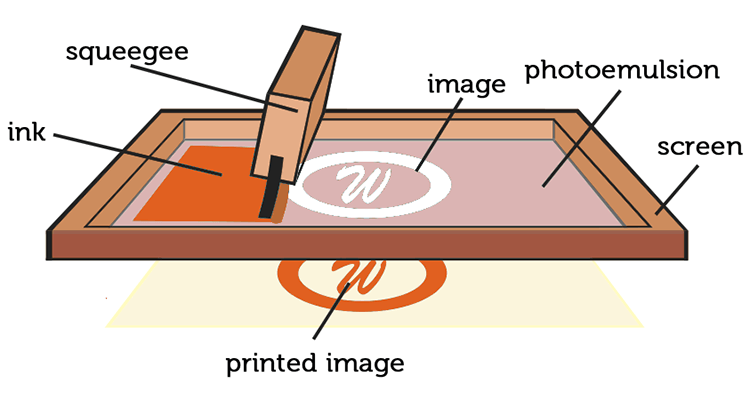The Best Guide To Tx Tees
Table of ContentsThe Single Strategy To Use For Tx TeesOur Tx Tees DiariesTx Tees Fundamentals ExplainedThe 2-Minute Rule for Tx TeesTx Tees Can Be Fun For AnyoneFascination About Tx TeesThe 6-Minute Rule for Tx Tees
That brings your total to approximately $1,900 prior to tax obligation and shipping. Accumulate various other prices, like the variety of utilities it requires to run the store and the expense of ink and solution per layout. custom cap printing. Take the print listed below. This is a one-color photo, so the expense of ink per tee shirt is roughly 20 cents.The solution should only be a couple of cents considering that you 'd just need to layer one display for this job. How much should you bill per shirt to make a revenue? Usually, printers try to make up to 45% earnings on a print work. Right here's a table to aid you identify that: complete price per item percent of preferred profit as a decimal (instance:.25 or.45) revenue made per thing per task Currently allowed's speak about the productivity of DTF.

With DTF, you can publish a handful of tee shirts, or just one. Both display printing and DTF have their particular niches in the globe.
Things about Tx Tees
The finest way to recognize? Ask around and see what printing shop like your own are doing. embroidery shop. Attempt both out and see which you like better
When you're selecting what sort of printing approach to make use of for publishing your artwork designs on your garments, it is very important that you recognize the distinctions in between these 2 techniques so you can optimize outcomes while decreasing prices. Screen printing is one of the most commonly used technique for publishing layouts on textiles.
DTG printing is also called place or straight to garment printing because it publishes just what is required as opposed to making a display as display printers do. https://businesslistingplus.com/profile/txtees02/. Screen printing functions by display filler squeegee screen printing ink display mesh screen, after that transferring the photo to garment using warmth and/or pressure
The DTG printer makes use of special dye-sublimation inks that are used right into a pre-designed picture by an electronic printing system. The inks enter into the fabric, enabling lively colors and phenomenal detail. It's additionally referred to as place or direct to garment printing due to the fact that it prints just what is needed rather of making a display as screen printers do.
8 Easy Facts About Tx Tees Explained
First, it's much faster - you can publish a fullcolor photo in mins, rather than hours for display printing. Second, there's no established time or costs included - you can print any type of layout you such as, without needing to create a screen first. Third, there's no waste - since screen printers screen print one style each time, they have to screen each color separately.
The paper is very expensive and can only be used once. Once it's printed on, it needs to be discarded. - The initial acquisition price is lower than the upfront investment of DTG printers- You can print multi-color layouts one display at once rather than having to print each color independently like DTG printing.

Tx Tees Fundamentals Explained
However, rather than making use of screen mesh as screen printers do, color sublimation printers make use of laser innovation to move your images onto garments or paper. A heat process moves the color from its solid-state directly into the gas phase which subsequently fuses it onto textile substrates when they are rapidly heated up to heats under high pressure.
Sublimation printing is eco-friendly. It utilizes less water than screenprinting, and due to the fact that it does not include using damaging solvents, it's secure for all kinds of apparel. The dye sublimation inks are also odor-free when treated, unlike display printers that make use of harmful chemicals during the screen printing process that leave behind an unpleasant odor.
They also save money on expensive devices like exposure systems considering that color sublimation printers do not call for a UV direct exposure device or a flash cure oven that is generally made use of in screen printing (custom more helpful hints t-shirt design). What is straight to garment printing (DTG Printing)? DTG printing is an electronic screenprinting procedure that publishes directly onto fabric using specialized inkjet printers
Tx Tees Things To Know Before You Get This
DTG printing uses lots of benefits over traditional screenprinting, consisting of the ability to publish photo top quality images, better color vibrancy, and the ability to print styles on darker fabrics. DTG printers function by heating the fabric ink up until it develops into a gas. The gas then penetrates the fabric, bonding with the fibers to develop a long-term print.

Screen printers just prepare their screen then start printing until they lack item or ink.- There is a variety of experienced display printers throughout the globe, which can be practical for newbies. - It's a slower procedure - screen printers commonly need to wait on the ink to dry before they can publish the following color- Screen printers require manual labor, so there's a greater learning contour and it takes longer to generate a high-quality layout- Display printing isn't as precise as DTG printing, so you may obtain some "blood loss" of colors from one component of the photo onto an additional otherwise done appropriately.
The Best Guide To Tx Tees
Rather of using screen mesh as display printers do, dye sublimation printers utilize laser technology to move your photos onto garments or paper. A warm procedure transfers the color from its solid-state straight into the gas stage which consequently integrates it onto fabric substratums when they are rapidly heated up to high temperature levels under high pressure.
Sublimation printing is eco-friendly. It utilizes much less water than screenprinting, and because it doesn't include using dangerous solvents, it's safe for all sorts of clothing. The color sublimation inks are also odor-free when healed, unlike screen printers that use dangerous chemicals throughout the screen printing process that leave behind an undesirable smell.
They also save money on expensive tools like exposure units because color sublimation printers do not need a UV direct exposure device or a flash treatment oven that is usually utilized in display printing. What is straight to garment printing (DTG Printing)? DTG printing is an electronic screenprinting procedure that publishes directly onto fabric utilizing specialized inkjet printers.
More About Tx Tees
DTG printing uses lots of benefits over conventional screenprinting, including the ability to print photo top quality photos, higher color vibrancy, and the ability to print layouts on darker textiles. DTG printers function by heating up the textile ink until it transforms right into a gas. The gas then permeates the textile, bonding with the fibers to develop an irreversible print.